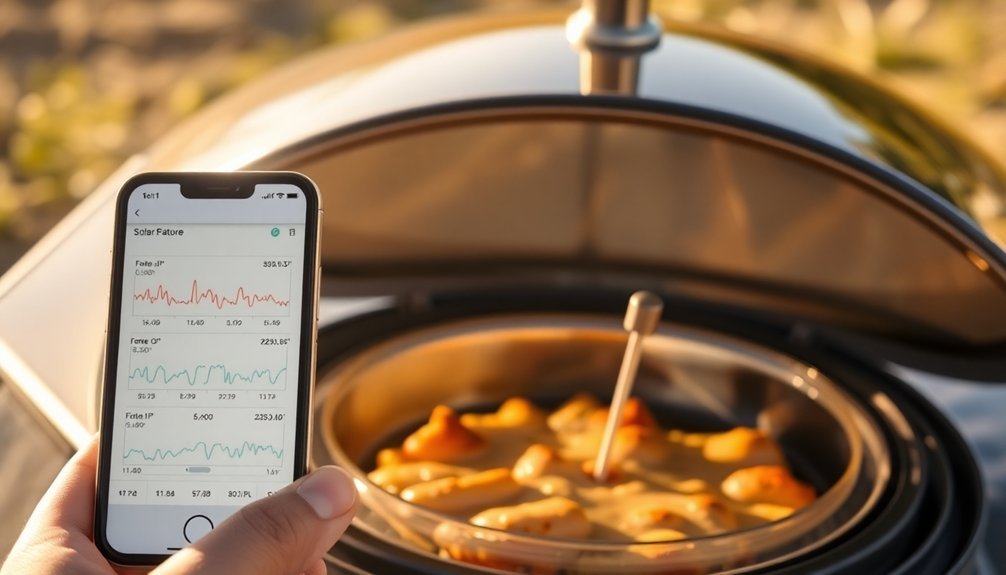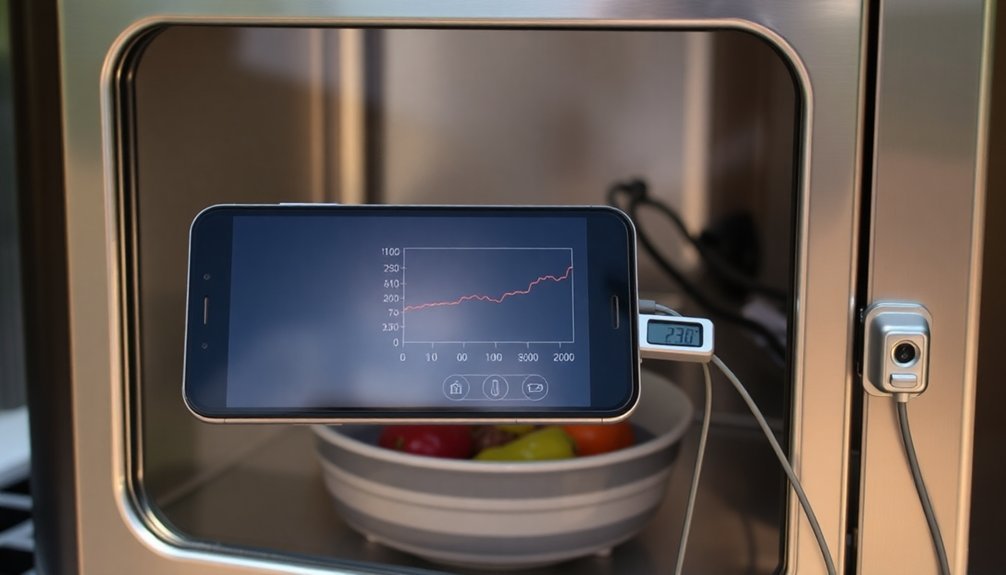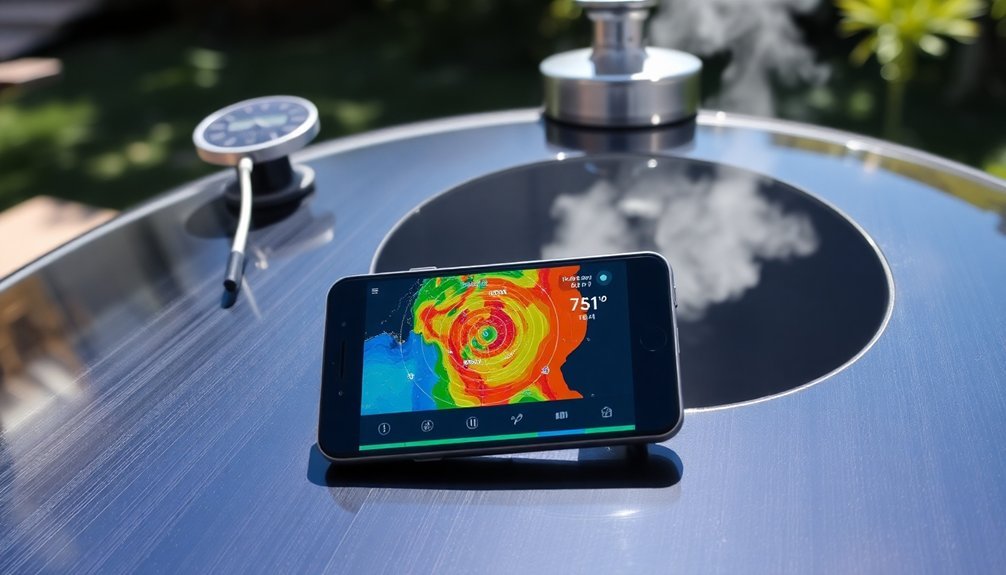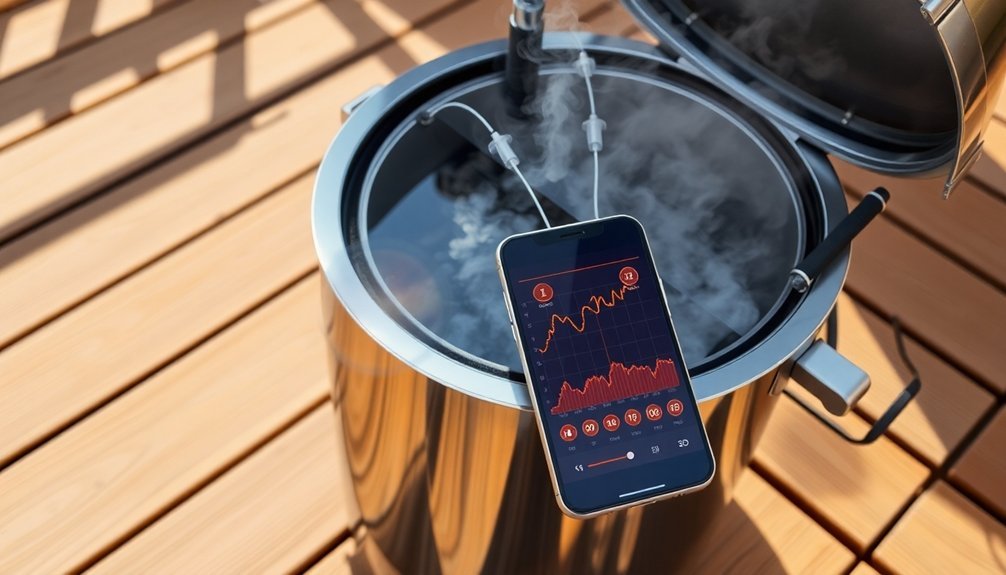The top 5 apps for tracking your solar oven cooking include GoSun App, which offers real-time temperature monitoring and recipe management; Solar Cooker Pro, featuring weather integration and cooking timers; SunTracker, providing dual-axis positioning guidance and heat distribution maps; CookSolar, with its user-friendly interface and customizable temperature alerts; and SolarChef, offering community sharing features and preset cooking profiles. You'll find these apps help optimize cooking times, maintain ideal temperatures, and connect with fellow solar chefs. Discover how these digital tools can transform your solar cooking experience from basic to precision-based cooking.
Understanding Solar Oven Temperature Apps
While solar cooking has gained popularity as an eco-friendly cooking method, tracking your oven's temperature is crucial for successful results. You'll need to monitor temperatures between 50°C and 300°C, with most cooking starting at 80°C to 90°C.
Temperature tracking apps can help you maintain ideal cooking conditions and guarantee food safety. Many apps are designed to work with motor-powered trackers that automatically adjust your solar oven's position throughout the day.
When choosing a solar oven temperature app, you'll want features that work with various thermometer types and can record data over time. The best apps integrate with solar oven trackers, allowing for unattended operation while maintaining constant temperatures through thermostat controls. This is particularly useful with advanced systems like vacuum tube cookers, which can reach temperatures up to 280°C.
Look for apps that can help you adjust your oven's alignment with the sun and optimize the tilt and reflector positions. Since solar cookers rely on conduction, convection, and radiation, you'll benefit from apps that monitor all these heating aspects.
For hybrid solar cookers that combine parabolic and vacuum tube technologies, choose apps that can track performance across various weather conditions, including cloudy and windy days.
Key Features For Tracking Success
Successful solar oven tracking relies on specific features that maximize your cooking efficiency and temperature control. You'll find that automated tracking systems offer the most precise sun-following capabilities, using photocells to detect sunlight and motors to adjust your oven's position throughout the day.
When selecting a tracking solution, you'll want to focus on platform stability first. Look for systems with sturdy steel bases and reliable clamp mechanisms that can securely hold your specific solar oven model. Whether you're using an All-American Sun Oven or another brand, guarantee the tracker's size compatibility matches your needs.
If you're considering a DIY approach, you can create an effective tracking system using basic components. You'll need small solar panels connected directly to DC motors, eliminating the need for batteries. This simple design proves both cost-effective and customizable to your requirements.
For peak performance, consider dual-axis tracking systems that follow the sun's movement both horizontally and vertically. These advanced setups typically use PV-motor solutions with built-in speed control to prevent overheating, guaranteeing your solar oven maintains ideal positioning throughout the cooking process.[TEXT]
Top Apps For Solar Cooking

Several powerful apps can transform your solar cooking experience, with options ranging from basic timer tools to sophisticated sun-tracking platforms. Solar Oven Buddy stands out as a top choice, offering precise cooking time estimates based on current weather conditions and solar intensity. When planning meals, keep in mind that a single load can feed 4-6 people comfortably.
If you're looking for the best cooker placement, Sun Surveyor provides detailed sun path diagrams and shadow analysis tools.
For thorough weather planning, Dark Sky's hyperlocal forecasts will help you determine the best times for solar cooking, while PVWatts lets you calculate the solar energy potential in your specific location. Sun Path helps you track the sun's movement throughout the day, ensuring you'll get maximum efficiency from your solar cooker.
You'll find these apps offer cross-platform compatibility, working seamlessly on both Android and iOS devices. Most importantly, they include offline functionality, which is essential when cooking in remote areas without internet access.
The user interfaces are intuitive, and you won't need technical expertise to navigate their features. With consistently high ratings above 4 stars and positive user reviews, these apps have proven their reliability in the solar cooking community.
Temperature Monitoring Best Practices
Understanding your solar oven's heat distribution patterns helps you enhance food placement and cooking times through mobile tracking.
Like medical-grade data loggers, using buffered probe sensors provides more accurate temperature readings compared to measuring air temperature alone.
You'll get better cooking results by using apps that monitor real-time temperature changes at different points in your solar oven.
Temperature control apps can alert you when adjustments are needed, such as repositioning the oven or modifying reflector angles to maintain ideal cooking heat.
Heat Distribution Patterns
Mastering heat distribution patterns in your solar oven starts with proper temperature monitoring. You'll need to understand how heat moves through your cooker to achieve the best cooking results. By positioning your reflectors correctly and considering seasonal solar declination angles, you can maximize heat concentration throughout your cooking chamber. Integrating a low-cost DC motor can help maintain optimal temperature control as the sun moves across the sky.
To effectively track heat patterns using your app, focus on these critical measurements:
- Solar irradiance levels – Monitor real-time sun intensity to predict temperature fluctuations and adjust cooking times accordingly
- Temperature gradients – Track heat distribution across different zones of your oven to identify hot spots and cold areas
- Heat retention rates – Record how well your oven maintains temperature when clouds pass or sun angle changes
Your app should help you validate your oven's design effectiveness through data logging. If you're using mirrors for heat concentration, you'll want to monitor both North-South and East-West reflector performance.
Consider using silicon rubber gaskets to prevent heat loss, and guarantee your app can integrate with self-contained data loggers for precise measurements. Remember to normalize your power estimates across different solar irradiance levels for consistent results.
Real-Time Temperature Controls
Accurate temperature control stands at the heart of successful solar oven cooking, and today's monitoring apps make this easier than ever. You'll find that most modern apps can connect to external digital thermometers with probes, giving you real-time temperature readings right on your smartphone.
When you're using these apps, you'll want to focus on maintaining temperatures between 250°-400° for ideal cooking. The apps will alert you if temperatures drop into the dangerous 50°-150° zone where bacteria can thrive.
You'll receive notifications when your solar oven needs adjusting, helping you prevent both overcooking and undercooking.
To make the most of your temperature monitoring app, you'll need to regularly check and adjust your oven's position throughout the cooking process. The app can guide you in optimizing reflector angles and managing partial shading when needed.
You can also track cooking times and temperature patterns, which helps you extend cooking duration by repositioning the oven away from direct sunlight when necessary.
Remember to use your app in conjunction with built-in thermometers for redundancy, ensuring your food reaches and maintains safe cooking temperatures throughout the process.
Digital Tools For Recipe Management

Modern digital tools have revolutionized recipe management for solar oven cooking, offering seamless organization and accessibility. You'll find specialized apps that provide a centralized database for your solar cooking recipes, complete with real-time updates and precise scaling features to adjust portions based on your solar oven's capacity.
These platforms also calculate nutritional information and track allergens, ensuring your solar-cooked meals meet dietary requirements.
To maximize your solar cooking experience, look for apps that offer these essential features:
- Temperature-specific recipe adjustments that account for varying sun conditions and cooking times
- Cloud-based storage that lets you access your solar recipes from any device, even when you're cooking outdoors
- Integration capabilities with weather apps to help you plan your solar cooking schedule effectively
When selecting a digital recipe management tool, prioritize options with user-friendly interfaces and customizable features that match your solar cooking style. You'll want software that can track cooking times, store temperature data, and help you maintain consistency across different seasons.
The best apps also include backup features to protect your carefully crafted solar recipes and provide thorough cost management tools for ingredient planning.
Real-Time Data Collection Methods
You'll find modern solar oven apps offer robust tracking features for temperature changes throughout your cooking sessions, giving you precise measurements at regular intervals.
Your app can monitor the sun's position and automatically suggest ideal oven placement times based on your geographical location and weather conditions.
Temperature Over Time Tracking
Tracking your solar oven's temperature over time has become remarkably straightforward with today's real-time data collection tools. Modern temperature monitoring systems use thermocouples and data loggers to capture precise readings throughout your cooking process. These tools integrate seamlessly with mobile apps, letting you monitor your solar oven's performance from anywhere.
To effectively track temperature patterns, you'll need to guarantee proper setup and maintenance:
- Calibrate your temperature sensors regularly to maintain accuracy and reliability in your readings.
- Set appropriate data collection intervals that capture meaningful temperature changes without overwhelming storage capacity.
- Account for environmental factors like wind and cloud cover by noting these conditions in your tracking system.
Your mobile app can display real-time temperature data, create historical graphs, and even alert you when temperatures fall outside your desired range. Cloud-based platforms make it easy to store and analyze your temperature data over extended periods.
Solar Position Monitoring Data
Real-time solar position monitoring has evolved substantially through advanced algorithms and satellite-based systems. When you're using a solar oven, you'll want to track the sun's position accurately to maximize your cooking efficiency.
The SAMPA algorithm offers incredibly precise calculations of solar angles, with uncertainties of just +/-0.0003 degrees, helping you position your solar oven in the most favorable position throughout the day.
You'll find the most up-to-date solar tracking data through services like Solcast, which combines satellite observations with weather models. The system updates every 5 to 15 minutes, giving you near-real-time information about solar conditions. With data resolution of 1-2km downscaled to 90 meters, you'll get highly localized information for your specific cooking location.
For the most accurate readings, you can pair your tracking app with physical measurement tools. Class B pyranometers will give you reliable plane-of-array irradiance measurements, while pyrheliometers can measure direct normal irradiance with a focused 5° view.
These measurements, combined with Solcast's minimal bias of +0.33% and ±2.47% standard deviation, guarantee you're getting reliable data for your solar cooking activities.
Energy Collection Rate Analysis
Modern energy collection rate analysis puts powerful data collection tools right at your fingertips. You'll find that today's solar cooking apps integrate seamlessly with temperature sensors and dataloggers to track your cooker's performance in real-time.
These applications can measure and record vital metrics like solar irradiance, ambient temperature, and internal cooking temperatures through your smartphone.
To maximize your solar cooker's efficiency, you'll want to focus on these key measurements:
- Thermal efficiency tracking – Apps calculate the ratio of energy absorbed by your food versus available solar energy using standardized equations.
- Exergy analysis – Advanced applications can help you identify energy losses and optimize your cooker's performance through precise measurements.
- Cooking power calculations – Real-time monitoring tools automatically adjust for varying conditions using the standard 700 W/m² normalization.
You can now download cooking data directly through OneWire Viewer software or similar platforms, making it easier than ever to analyze your solar cooker's performance. Many apps also incorporate ANN models to predict cooking times and temperatures based on current conditions, helping you achieve more consistent results in your solar cooking endeavors.
Weather Integration For Solar Cooking

Successful solar cooking relies heavily on accurate weather data integration. When you're using solar cooking apps, you'll want features that track multiple weather variables affecting your cooking efficiency. Look for apps that monitor solar irradiation levels, humidity, cloud cover, and wind speeds – all vital factors that impact your cooking times.
Your app should provide real-time updates and forecasts to help you position your solar cooker ideally throughout the day. It's critical to have notifications that alert you when conditions change, especially during longer cooking sessions.
The best apps will recommend adjustments to your cooker's position and suggest preheating times based on current weather conditions.
For thorough weather integration, choose apps that include latitude-specific calculations and seasonal variations. They should factor in your location's solar noon timing and provide guidance on reflector angles for maximum efficiency.
Look for features that estimate cooking times based on weather conditions and suggest alternative cooking methods when solar cooking isn't ideal. The most effective apps will integrate with local weather stations and satellite data to provide accurate, hyperlocal weather information for your specific cooking location.
App-Based Solar Cooking Communities
App-based solar cooking communities bring together enthusiasts from around the globe to share experiences, recipes, and technical knowledge. You'll find vibrant forums and social media groups where users actively discuss different solar cooker models, share performance reviews, and organize local meetups.
These digital platforms serve as invaluable resources for both beginners and experienced solar chefs.
Through these apps, you can access thorough educational content, including step-by-step tutorials, safety guidelines, and maintenance tips. You'll also discover recipe collections specifically tailored for solar cooking, along with real-world success stories from community members.
- Connect with expert solar chefs who provide technical support and answer your questions through Q&A sessions
- Share your own experiences and contribute to the growing knowledge base of solar cooking techniques
- Access DIY solar cooker designs and get personalized recommendations for choosing the right model
The feedback system within these apps helps you make informed decisions about solar cooker purchases while staying updated on the latest innovations. You can troubleshoot common issues, track your cooking progress, and contribute to discussions about environmental benefits of solar cooking.
Smart Temperature Alerts Systems

Temperature monitoring revolutionizes solar oven cooking through intelligent alert systems that keep you informed about your food's progress. Using thermocouples and smart sensors, these systems provide real-time updates on your food's temperature directly to your mobile device, ensuring ideal cooking conditions.
Modern solar oven apps integrate weather data and thermal models to predict cooking times and temperatures. They'll alert you when your food reaches specific temperature thresholds or if adjustments are needed due to changing weather conditions.
Three strategically placed photoresistors track sunlight intensity, helping you maintain perfect oven positioning throughout the day.
The most effective apps connect to IoT-enabled solar ovens with servo motors that automatically adjust the reflectors' orientation. You won't need to manually reposition your oven, as the system tracks the sun's movement and enhances thermal performance. These smart features calculate heat loss and make necessary adjustments to maintain consistent cooking temperatures.
When selecting a solar cooking app, look for ones that offer web visualizations and real-time status updates. You'll benefit from features like temperature graphs, cooking progress indicators, and instant notifications when your food reaches the desired temperature.
Frequently Asked Questions
Can Solar Oven Cooking Apps Work Offline in Remote Camping Locations?
You'll face challenges finding offline solar oven cooking apps since they don't currently exist. When camping remotely, you're better off relying on printed guides and your own temperature tracking methods.
How Accurately Do Apps Predict Cooking Times During Partially Cloudy Weather?
During partially cloudy weather, you'll find cooking time predictions are less accurate, varying by 25-40%. Your actual cooking times will fluctuate as clouds affect solar irradiance, requiring you to monitor and adjust accordingly.
Are Solar Cooking Apps Compatible With Different Brands of Solar Ovens?
You'll find that solar cooking apps aren't universally compatible with all oven brands. It's best to check specific compatibility details for your solar oven model or test different apps to confirm they work properly.
Do Tracking Apps Account for Seasonal Changes in Sun Intensity?
Yes, you'll find that most solar tracking apps adjust for seasonal variations. They'll calculate sun intensity based on your location, date, and time, helping you optimize your cooking position throughout the year.
Can Multiple Users Monitor the Same Solar Oven Through Shared App Access?
Yes, you'll find most modern solar monitoring apps support multi-user access. You can share your solar oven's data with family or team members through centralized platforms, allowing everyone to track performance simultaneously.
In Summary
You'll find these solar oven tracking apps transform your outdoor cooking experience by putting crucial data at your fingertips. Whether you're monitoring temperatures, managing recipes, or connecting with fellow solar chefs, these digital tools make success more achievable. Start with one app that fits your needs, then explore additional features as you gain confidence. Your solar cooking journey just got smarter and more precise.





Leave a Reply